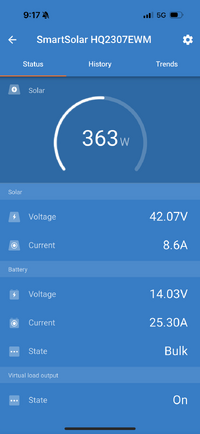Of course I forgot you had split it all up ..............
I'm probably wrong but I think if you have 2 separate strings in series but joined together individually at the controller then its series connected in parallel so the controller would only see the prime voltage being 44v or whatever ,2 x the VMP of one string on the controller screen not 4 x VMP .......... all your panels would have to be connected in series and run to the controller for you to see a higher voltage ...... So a NEG of one string connected to POS of the other string with the other Neg and Pos connected to the controller ....... then again if all wired together and just a shi*ty day,shadow could have knocked out a set or they are only making 11 volts each ...
In vans I can't see a need for series, van cable length is not really an issue, higher volts means less amps which means less charge capability and when I have tested mine the voltage drop is bugga all, even with the 8B&G 10m and 5m extenstion cables run out but the amps produced by the lower voltage is greater by far than with higher volts and AMPs are what gives the battery its grunt ......................
So all in all everything good, should have stayed out there I think with this weather......
I'm probably wrong but I think if you have 2 separate strings in series but joined together individually at the controller then its series connected in parallel so the controller would only see the prime voltage being 44v or whatever ,2 x the VMP of one string on the controller screen not 4 x VMP .......... all your panels would have to be connected in series and run to the controller for you to see a higher voltage ...... So a NEG of one string connected to POS of the other string with the other Neg and Pos connected to the controller ....... then again if all wired together and just a shi*ty day,shadow could have knocked out a set or they are only making 11 volts each ...
In vans I can't see a need for series, van cable length is not really an issue, higher volts means less amps which means less charge capability and when I have tested mine the voltage drop is bugga all, even with the 8B&G 10m and 5m extenstion cables run out but the amps produced by the lower voltage is greater by far than with higher volts and AMPs are what gives the battery its grunt ......................
So all in all everything good, should have stayed out there I think with this weather......
Last edited:

